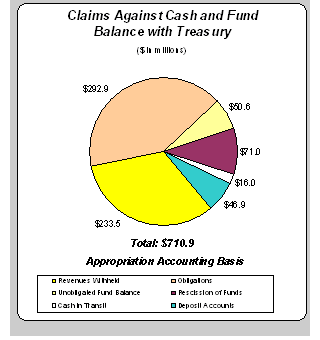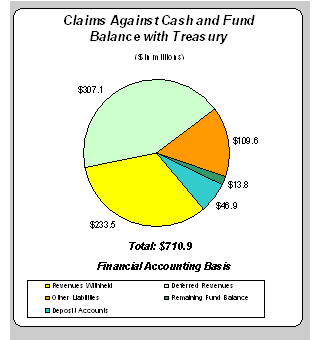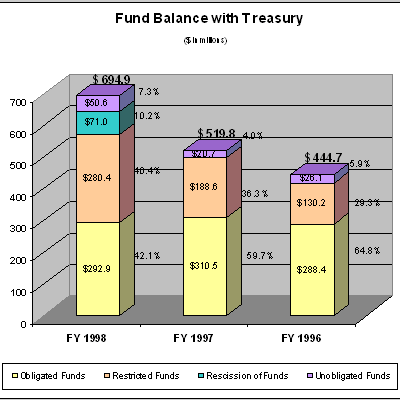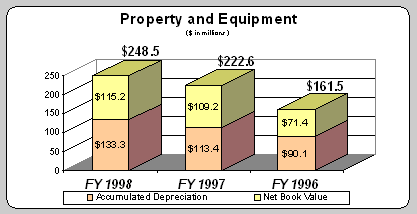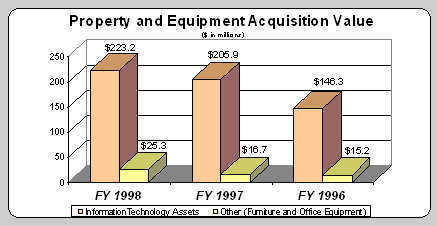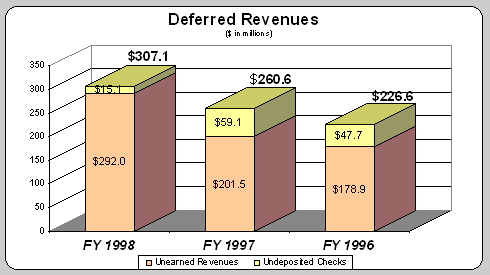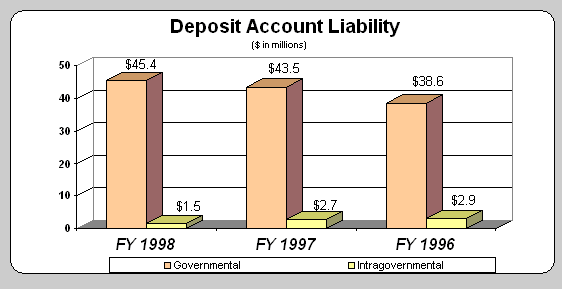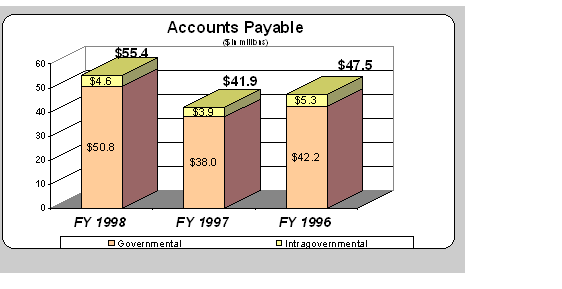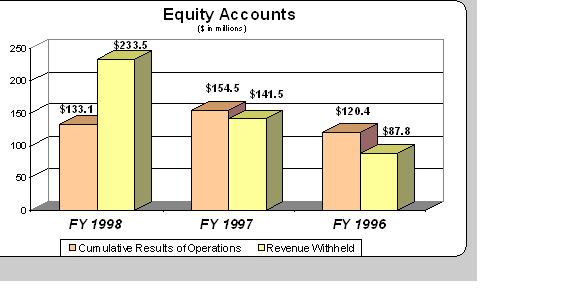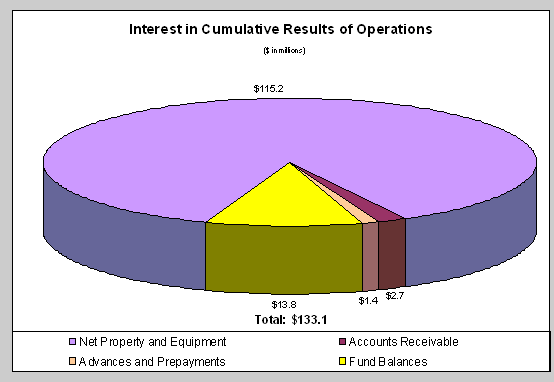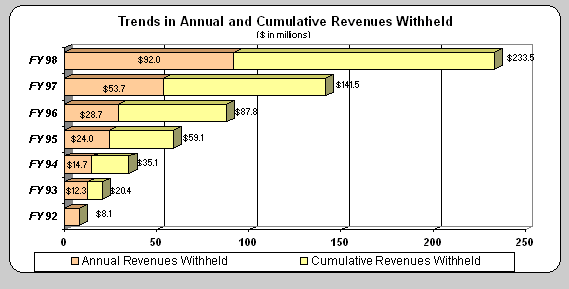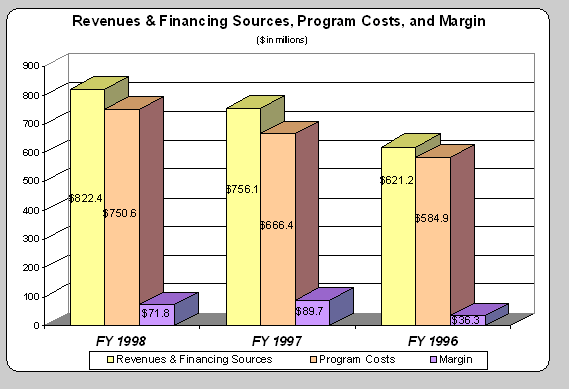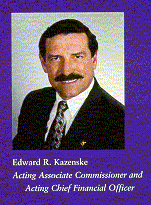
Message from the Acting Chief Financial Officer
As the Chief Financial Officer (CFO) of the U.S. Patent and Trademark Office (PTO), I am pleased to present our FY 1998 financial statements. This is the seventh consecutive year that we have prepared annual financial statements. As in previous years, our FY 1998 financial statements have earned an unqualified audit opinion from the Office of Inspector General (OIG) for the Department of Commerce. Moreover, since becoming CFO in 1997, this is the second consecutive year that the OIG has not identified and reported any material weaknesses in our internal control structure.
The PTO realized significant financial growth during FY 1998 while restrictions on our use of revenues continued. Our assets increased 19.6 percent, rising from $694 million to $830 million; at the same time, our liabilities increased just 16.6 percent, from $398 million to $464 million. Revenues climbed to more than $800 million, a 9.0 percent increase over the previous year. The result of the FY 1998 appropriation process required the PTO to deposit $92 million into a restricted account and placed an annual limitation on our authority to spend new fee collections. In addition, the FY 1999 appropriations bill, enacted on October 21, 1998, rescinded $71 million of the PTO's prior year revenues.
As always, our focus is on identifying and implementing business practice improvements that will benefit both our internal and external customers. On November 10, 1998, the U.S. Patent and Trademark Office Reauthorization Act, Fiscal Year 1999, was enacted, introducing a reduction in patent fees for FY 1999. During FY 1998, we made significant financial management improvements. We have continued to improve our sound financial structure as Federal financial reporting progressed towards linking the Federal budget to financial operating results. In accordance with the new requirements of the Office of Management and Budget Bulletin Number 97-01, Form and Content of Agency Financial Statements, the PTO has prepared several new financial statements to include a Statement of Net Cost, a Statement of Budgetary Resources, and a Statement of Financing. We are also on course to achieve a fully integrated financial management system that will enable easy access to reliable and timely financial information. Our significant accomplishments include the use of enterprise-wide data warehousing, the implementation of a PTO-wide cost accounting system, the addition of electronic commerce capabilities to our procurement system, and an improved asset management system. In addition, plans have been put in place for future enhancements to our travel subsystem, fixed asset subsystem, and revenue accounting system-to include the capability to accept credit card payments over the Internet.
The PTO continues to be a financial and management leader among Federal agencies. We have made substantial progress toward resolving the Year 2000 issue; we have moved our major systems to client/server architecture running enterprise-wide, open systems software and Microsoft Windows NT; and we are increasing our use of the Internet and the latest technologies for data storage and transmission.
As we meet the challenges that lie ahead, all of us in the CFO organization look forward to working with our customers, stakeholders, and employees, to deliver the services, management policies, financial systems and fiscal stewardship that will have the PTO successfully prepared for the new millennium.
Sincerely,

Edward R. Kazenske
Acting Associate Commissioner and Acting Chief Financial Officer
Financial Discussion and Analysis
Significant Changes and Accomplishments
Financial Reporting
The PTO has prepared its FY 1998 financial statements in accordance with the requirements of the Office of Management and Budget (OMB) Bulletin Number 97-01, Form and Content of Agency Financial Statements, and supplementary guidance provided by the Department of Commerce (DOC). OMB Bulletin Number 97-01 incorporates the concepts and standards contained in the Statements of Federal Financial Accounting Concepts (SFFAC) and the Statements of Federal Financial Accounting Standards (SFFAS) recommended by the Federal Accounting Standards Advisory Board and approved by the Secretary of the U.S. Department of the Treasury (Treasury), the Director of the OMB, and the Comptroller General. These concepts and standards have been promulgated to help Federal agencies comply with the requirements of the Chief Financial Officers Act of 1990 as amended by the Government Management and Reform Act of 1994. These two acts demand greater financial accountability from Federal agencies and require the integration of accounting, financial management, and cost accounting systems.
Pursuant to the OMB guidance, the PTO's FY 1998 financial statements include the following new statements:
- the Statement of Net Cost, which presents the annual net cost (income) of the PTO's programs by responsibility segment
- the Statement of Budgetary Resources, which presents information about the sources of budgetary resources during the fiscal year and their status at fiscal year-end
- the Statement of Financing, which reconciles the differences between the PTO's budgetary obligations incurred during the fiscal year and proprietary annual net cost (income) of programs
The PTO is also presenting a Statement of Cash Flows as supplemental information. The PTO operates in a business-like manner and it is meaningful to understand the sources and uses of cash provided to the PTO by its operating and investing activities.
The PTO is a leader among Federal agencies in financial reporting, and this is the seventh consecutive year that it has provided its customers and stakeholders with a comprehensive set of financial statements with related footnote disclosures. During FY 1998, the PTO also became the first agency to transmit its Federal Agencies' Centralized Trial Balance System (FACTS) II budgetary trial balance to the Treasury under the FACTS II pilot program, an achievement that required the successful early implementation of the U.S. Standard General Ledger budgetary accounting model changes. As in past years, the DOC Office of Inspector General (OIG) audited the PTO's FY 1998 financial statements, and provided an unqualified opinion. This opinion recognizes the financial statements as fairly presented and in conformance with the stringent new requirements of the Federal government's accounting and reporting standards.
The PTO places the highest priority on sound financial management and is continually working to improve its accounting and reporting policies and procedures. The OIG also makes annual recommendations for improving internal controls and operating efficiencies in its Report on Internal Control Structure. As a result of the PTO's success in implementing corrective actions, for a second consecutive year the OIG did not identify any material weaknesses in the PTO's internal control structure. In addition, the number of reportable conditions identified by the OIG decreased from three in FY 1997 to one in FY 1998. The reportable conditions from FY 1997 have all been resolved and closed. The new reportable condition, related to information systems general controls, will be addressed by PTO management and resolved in FY 1999.
Appropriations Accounting vs. Financial Accounting
Although the PTO prepares and publishes its financial statements on an accrual basis, it still operates on the cash basis required by appropriations law. The PTO has no investment authority, no borrowing authority, and no lines of credit. For the PTO to spend a single dollar, it must have already collected that dollar. By the end of the fiscal year, the fees collected and deposited in the Fund Balance with Treasury account must cover all outstanding obligations for goods or services ordered but not yet delivered. Under generally accepted accounting and reporting requirements, these outstanding obligations, or contracts and commitments, do not appear on the financial statements until the goods or services have been provided.
The unobligated fund balance at the end of FY 1998 was $121.6 million, of which the Treasury will rescind $71.0 million at the direction of the FY 1999 appropriations bill. This leaves $50.6 million available to the PTO at the beginning of FY 1999. Cash and the Fund Balance with Treasury, which include funds that will be used to liquidate current outstanding obligations, show a total of $710.9 million. The PTO's financial statements, if interpreted on a cash-basis, may lead the reader to the conclusion that the PTO's cash and Fund Balance with Treasury are funds available for obligation, rather than funds that have previously been obligated and that will be used to liquidate current outstanding obligations. Private enterprises would obviously not have these commitments for outstanding obligations outside the financial statements, and would not keep such large fund balances on hand without investing them.
The charts below illustrate the differences between accounting for cash and Fund Balance with Treasury on the appropriations accounting basis, as used in the budgeting process, and the financial accounting basis, as reported in the financial statements.
Expiration of OBRA Surcharge
At the end of FY 1998, the patent fee surcharge established in the Omnibus Budget and Reconciliation Act (OBRA) of 1990, as amended in 1993, expired. The OBRA legislation provided for the collection of a patent fee surcharge to enable the PTO to finance the cost of its operations from user fees rather than from taxes paid to the general fund of the Treasury. The OBRA legislation required the PTO to deposit specified amounts of fees into a special fund receipt account at Treasury each year. By the end of FY 1998, the fund balance had reached $233.5 million.
Although the PTO collected these fees, Congress controls their use. The PTO requires budget authority to use these funds, and the entire fund balance will remain restricted until Congress appropriates them to the PTO. After the expiration of the OBRA, the President of the United States enacted the U.S. Patent and Trademark Office Reauthorization Act, Fiscal Year 1999, on November 10, 1998, providing a modest reduction in patent fees beginning in FY 1999.
Cost Accounting System
The PTO is one of the first Federal agencies to have successfully implemented an enterprise-wide, activity-based cost/management system. This was accomplished in compliance with SFFAS Number 4, Managerial Cost Accounting Concepts and Standards for the Federal Government. Using this cost accounting system, the PTO is able to collect and analyze, on an agency-wide basis, the costs associated with processes and services provided to internal and external customers, and to use this information to improve its resource management. Specifically, the system provides for better management and control of costs against revenues, enables more effective decision-making, and provides greater accountability of incurred costs.
Year 2000
The Year 2000 (Y2K) issue affects computer systems that are not programmed to recognize dates in the year 2000. Time-sensitive programs may be susceptible to major system failure or miscalculations. The PTO has identified all systems at risk and evaluated the changes to its hardware and software necessary to ensure that its computer systems will function properly for dates in the year 2000 and thereafter. The PTO has successfully converted its core accounting and other financial management systems to recognize the year 2000.
The PTO has also initiated discussions with other agencies, significant vendors, customers, and financial institutions to ensure that those parties have addressed the Y2K issue where their systems interface with the PTO's systems or otherwise impact its operations. The PTO is assessing the extent to which its operations are vulnerable should those organizations fail to properly protect their systems.
A team of internal staff is managing the PTO's Y2K initiative with the assistance of outside consultants. The team's activities are designed to ensure that there is no adverse effect on the PTO's core business operations, and that transactions with other agencies, significant vendors, customers, and financial institutions are fully supported. Completion of the Y2K project for all PTO systems is scheduled for the end of FY 1999.
Fee Collection
The PTO remained a leader among Federal agencies in using emerging technologies to upgrade its fee collection techniques. The Discover card and the American Express card were accepted for the first time in FY 1998. Including Visa and Mastercard payments, the PTO recorded 36,114 credit card transactions for a total of $1.5 million in FY 1998. The PTO also pursued an aggressive electronic commerce strategy. Effective October 1, 1998, the PTO began accepting credit card payments over the Internet for trademark applications. The PTO is one of the first Federal agencies to implement secured socket layer (SSL) electronic commerce without Treasury assistance and in accordance with the latest Treasury regulations. By March 31, 1999, the PTO plans to expand its electronic commerce activity to include sales of patent and trademark information.
Cash and Fund Balance with Treasury 1
The PTO began FY 1998 with $580.7 million in its cash accounts and Fund Balance with Treasury. Of this, $310.5 million was set aside for the payment of obligations, $141.5 million was withheld from the PTO as required by the OBRA, $60.9 million represented checks in transit, $46.2 million represented moneys held in trust for the PTO's customers, and $0.9 million was reserved for a rescission of restricted funds. Only $20.7 million - or 3.6 percent - of the PTO's cash accounts and Fund Balance with Treasury was available to meet patent and trademark program needs arising in FY 1998 and beyond.
During FY 1998, the PTO generated a net of $198.3 million in cash from patent and trademark fees and other operating activities, an increase of $26.7 million, or 15.6 percent, over the $171.6 million generated during FY 1997. The increase between FY 1996 and FY 1997 was $37.1 million, or 27.6 percent. The slower rate of growth in FY 1998 was the result of several factors, the most significant of which was the smaller increase in total revenues and financing sources between FY 1997 and FY 1998. Revenues and financing sources grew 21.7 percent between FY 1996 and FY 1997, but only 8.7 percent between FY 1997 and FY 1998.
The net cash provided by operating activities in FY 1998 consisted primarily of excess revenues and financing sources over total program costs. The figures cited are adjusted for depreciation, amortization and appropriated capital used (non-cash expenses); plus increases in deferred revenues, accounts payable, customer deposit accounts, accrued leave, accrued post-employment compensation, and accrued payroll and benefits, and a decrease in accounts receivable; less an increase in advances and prepayments and decreases in the actuarial liability and other liabilities.
Of the $198.3 million generated from operating activities, $68.1 million was invested in new property and equipment, principally automation technology. This amount represents a decrease of $15.3 million from the $83.4 million of net cash invested in property and equipment during FY 1997.
The FY 1997 investment in property and equipment was an increase of $34.4 million over the $49.0 million of net cash invested in property and equipment during FY 1996. The increase between FY 1996 and FY 1997 and the subsequent decrease between FY 1997 and FY 1998 primarily reflect the purchase of network computers and patent storage equipment in FY 1997, and the tapering-off of these purchases in FY 1998.
Due in part to the reduction in capital equipment expenditures in FY 1998, total net cash provided from operating and investing activities was $130.2 million, an increase of 47.6 percent over the $88.2 million provided during FY 1997. This compares to an increase of 3.0 percent over the $85.6 million provided during FY 1996.
The PTO ended FY 1998 with a total of $710.9 million in its cash accounts and Fund Balance with Treasury. Of this amount, $292.9 million was set aside for the payment of obligations, $233.5 million was withheld from the PTO as required by the OBRA, $16.0 million represented checks in transit, $46.9 million represented moneys held in trust for the PTO's customers, and $71.0 million was earmarked for a rescission. Only $50.6 million - or 7.1 percent - of the PTO's ending cash accounts and Fund Balance with Treasury is available to meet patent and trademark program needs arising in FY 1999 and future years.
The accompanying chart indicates the portions of the Fund Balance with Treasury that represent obligated funds, unobligated funds, and restricted or rescinded funds.
Property and Equipment
At the end of FY 1998, the PTO's property and equipment (P&E) was stated at a net book value of $115.2 million. This represents the original acquisition value of $248.5 million less accumulated depreciation of $133.3 million. The net book value increased $6.0 million, or 5.5 percent, over the FY 1997 balance of $109.2 million. The increase between the FY 1996 net P&E balance of $71.4 million and the FY 1997 balance was $37.8 million, or 52.9 percent. These increases reflect the PTO's substantial and sustained commitment to automation technology.
Property and equipment is the PTO's largest owned asset. Investment in automation technology has increased substantially in recent years, as many processes migrate from paper-based to electronic systems, as old equipment is replaced with newer technology, and as operating and application software is upgraded to keep pace with equipment capabilities and emerging technology. Leveraging information technology enables the PTO to improve and enhance the current business process and add new capabilities through migrating automated information systems to operate on an evolving information technology infrastructure.
This systematic upgrading of the PTO's information technology infrastructure is designed to streamline the patent and trademark processes and improve responsiveness to customer needs, and is projected to continue into the twenty-first century. The following chart depicts the acquisition value of the PTO's P&E from FY 1996 through FY 1998.
Deferred Revenues
The PTO's largest liabilities are deferred revenues from fees received for services requested but not fully provided and earned. The deferred revenues calculations encompass undeposited checks at year-end, and distinguish between fees collected and income realized as patent and trademark applications pass through the various examination and processing stages. Total deferred revenues at the end of FY 1998 were $307.1 million, an increase of $46.5 million, or 17.8 percent over the FY 1997 balance of $260.6 million. The increase from the FY 1996 balance of $226.6 million to the FY 1997 total was $34.0 million, or 15.0 percent. For the past two fiscal years, the increase in patent and trademark workload has exceeded the growth in patent and trademark production. The combination of increased fees and pendency factors has caused unearned revenues to rise.
In FY 1998, the PTO received 240,090 utility, plant and reissue (UPR) patent applications and 16,576 design applications. The UPR application filing workload increased 8.7 percent from the FY 1997 level of 220,773 UPR applications. This compares to an increase of 15.5 percent between the FY 1996 total of 191,116 UPR applications and the FY 1997 figure. Design applications increased 1.9 percent from the FY 1997 level of 16,272 applications. This compares to an increase of 7.3 percent between the FY 1996 total of 15,160 applications and the FY 1997 total.
During FY 1998, the PTO received 232,384 trademark applications, an increase of 3.6 percent from the FY 1997 filing level of 224,355 applications. In comparison, there was an increase of 11.8 percent between the FY 1996 filing level of 200,640 trademark applications and the FY 1997 figure.
Although total deferred revenues increased in FY 1998, the undeposited checks component of the PTO's deferred revenue liability decreased 74.5 percent from $59.1 million at the end of FY 1997 to $15.1 million at the end of FY 1998. This compares to an increase of 23.9 percent between the FY 1996 amount of $47.7 million and the FY 1997 total. The decrease in undeposited checks between FY 1997 and FY 1998 is attributable to improvements in the patents pre-examination process. The increase from FY 1996 to FY 1997 was attributed to a run on fee filings at the end of FY 1997 as PTO customers sought to avoid fee increases that became effective October 1, 1997.
Customer Deposit Accounts
The PTO maintains customer deposit accounts as a service to its clients. The customer deposit accounts liability results from moneys paid to the PTO in anticipation of a future demand for services. On receipt of a service request from a customer maintaining a deposit account, the PTO deducts the appropriate fee from the respective account.
At the end of FY 1998, the liability was $46.9 million, an increase of 1.5 percent over the FY 1997 balance of $46.2 million. The increase between the FY 1996 balance of $41.5 million and the FY 1997 balance was $4.7 million, or 11.3 percent. These increases are consistent with the increases in demand for patents and trademarks, as discussed in the Deferred Revenues section.
Accounts Payable
The PTO's accounts payable balances include Federal and non-Federal accounts payable for goods and services received for which the PTO has not yet made payment. At the end of FY 1998, payments owed to other Federal agencies (intragovernmental transactions) totaled $4.6 million, a $0.7 million increase over the $3.9 million owed at the end of FY 1997. This compares to a decrease of $1.4 million between the balance of $5.3 million owed at the end of FY 1996 and that owed at the end of FY 1997.
The downward trend from the FY 1996 balance in Federal accounts payable is consistent with the PTO's efforts in recent years to expedite the payment, posting, and reporting of interagency charges. At the end of FY 1998, Federal accounts payable represented 8.3 percent of the total accounts payable balance, compared to 9.3 percent in FY 1997 and 11.2 percent in FY 1996. Additionally, the processing of interagency charges required an average of 22 days in FY 1998, compared to 29 days in FY 1996.
At the end of FY 1998, $50.8 million was owed to non-Federal entities (governmental transactions), a $12.8 million increase over the $38.0 million owed at the end of FY 1997. The amount owed at the end of FY 1997 declined by $4.2 million from the balance of $42.2 million owed at the end of FY 1996.
The increase in accounts payable from FY 1997 to FY 1998 can be attributed primarily to the accrual of charges relating to certain major contracts that existed in FY 1997 but which were significantly less active at that time. The decrease in the accounts payable balance from FY 1996 to FY 1997 is attributed primarily to the PTO's efforts to fully comply with the requirements of the Prompt Payment Act. The PTO made 99.5 percent of its vendor payments on time in FY 1998.
Net Position
The PTO reports net position in two components: cumulative results of operations, and revenues withheld. In the aggregate, the net position section of the balance sheet is also referred to as equity. Equity is the residual interest in the assets of an entity that remains after deducting liabilities.
The total net position at the end of FY 1998 was $366.6 million, an increase of $70.6 million from the FY 1997 total of $296.0 million. The FY 1997 net position represented an increase of $87.8 million from the FY 1996 total of $208.2 million. The FY 1998 total includes $233.5 million that is unavailable for use until further Congressional action. This total comprises $92.0 million from FY 1998 and $141.5 million cumulative from prior years.
From FY 1996 to FY 1998, the overall increase in the restricted revenues withheld component of the PTO's equity has outpaced the increase in the unrestricted cumulative results of operations component. The restricted component increased 61.2 percent from FY 1996 to FY 1997, and 65.0 percent from FY 1997 to FY 1998. The unrestricted component increased 28.3 percent from FY 1996 to FY 1997, and decreased 13.9 percent from FY 1997 to FY 1998. A discussion of each of the two components of equity follows.
Cumulative Results of Operations
The cumulative results of operations (CRO) is the cumulative unrestricted net operating surplus recognized by the PTO since its inception. In theory, the CRO should increase each year by the difference between revenues and financing sources and total expenses. In practice, less than the entire amount is added to the CRO, as a portion is diverted into a restricted revenues withheld account at the Treasury. These fee collections offset spending in other Federal programs, which reduces the PTO's budget authority and restricts its ability to spend all of its customers' fees to accomplish patent and trademark program objectives.
At the end of FY 1998, the PTO's CRO was $133.1 million, comprising net P&E in the amount of $115.2 million, non-cash assets totaling $4.1 million, and the PTO's interest in the Fund Balance, a total of $13.8 million.
The $13.8 million interest in the Fund Balance is calculated on a financial accounting basis and does not reflect the impact of the PTO's obligation for $222.8 million in unpaid undelivered orders (goods and services ordered, but not yet received) on the appropriation accounting basis. The PTO's interest in the Fund Balances will be used to liquidate a portion of its commitments for these unpaid undelivered orders. However, future funding requirements in the amount of $209.0 million will have to be earned to liquidate the remainder of its unpaid undelivered orders and to meet its liabilities, both funded and unfunded, at September 30, 1998.
Revenues Withheld
Revenues withheld are segregated as a portion of the equity balance because of the OBRA restrictions on the availability of these customer-paid fees. Although the fees are earned by the PTO, they can be made available for use only on the authorization of Congress.
During FY 1998, the PTO collected and deposited $119.0 million of customer fees into the special restricted Treasury account. Congress provided budget authority for the PTO to spend $27.0 million of these fees, with $92.0 million remaining in the restricted Treasury account.
From FY 1992 through FY 1998, Congress withheld increasing amounts of the PTO's customer fees, pursuant to OBRA legislation. Initially, the amounts withheld were small compared to the PTO's revenues, but they have increased over time. Annual amounts withheld ranged from $8.1 million in FY 1992 to $92.0 million in FY 1998.
Revenues withheld reached $233.5 million at the end of FY 1998, an increase of 65.0 percent over the FY 1997 balance of $141.5 million. The FY 1997 balance in turn represented an increase of 61.2 percent over the FY 1996 balance of $87.8 million.
The OBRA surcharge requirement expired at the end of FY 1998. Although the PTO will not deposit additional funds into the restricted account during FY 1999, the entire fund balance of $233.5 million remains unavailable for the PTO's use until such time as Congress appropriates it.
Results of Operations
The following table shows key revenue and cost classifications as a percentage of total earned revenues and other financing sources:
FY 1998 | FY 1997 | FY 1996 | |
|---|---|---|---|
Earned Revenues | |||
Sales of Goods and Services to the Public | 96.76% | 96.45% | 98.95% |
| Sales of Goods and Services (Intragovernmental) | 0.54% | 0.60% | 0.68% |
Total Earned Revenues | 97.30% | 97.05% | 99.63% |
Other Financing Sources | |||
Appropriated Capital Used | 0.16% | 0.25% | 0.37% |
Imputed Financing Sources | 2.54% | 2.70% | 0.00% |
Total Other Financing Sources | 2.70% | 2.95% | 0.37% |
Total Earned Revenues and Other Financing Sources | 100.00% | 100.00% | 100.00% |
Program Costs | |||
Operating Expenses | 83.71% | 82.11% | 89.22% |
Depreciation and Amortization | 7.56% | 6.02% | 4.94% |
Total Program Costs | 91.27% | 88.13% | 94.16% |
Net Increase in Cumulative Results of Operations | 8.73% | 11.87% | 5.84% |
Total | 100.00% | 100.00% | 100.00% |
Earned Revenues
The PTO's revenues and financing sources are primarily derived from the sale of goods and services, and include user fees for patent and trademark rights, grants, registrations, and related products. Concern for the protection of intellectual property rights increases each year, and as demand for the PTO's products and services has risen, both domestically and internationally, fee collections have also continued to climb. The PTO's earned fee revenues and reimbursements for FY 1998 reached $800.2 million, an all-time high. Of this amount, 86.4 percent ($691.3 million) was generated by the patents program area, 9.8 percent ($78.5 million) by the trademarks program area, and 3.8 percent ($30.4 million) by the information dissemination program area.
Appropriated capital used during FY 1998 accounted for $1.3 million. In addition, $20.9 million was recognized as an imputed financing source resulting from the PTO's recognition of its share of the cost to the Federal government of providing pension and post-retirement health and life insurance benefits to all eligible employees.
Customers pay user fees when products and services are ordered. The current patent fee structure sets low initial application fees. Income from other sources, such as patent maintenance fees, supplements these initial fees to cover the full cost of the patent examination and issuance process, as well as other PTO operations such as patent documentation and quality reviews.
Total earned income on the financial accounting basis from patent and trademark fee collections, and reimbursements in FY 1998 was $800.2 million, an increase of 9.0 percent from the FY 1997 total of $733.9 million. The FY 1997 total was an 18.6 percent increase over the FY 1996 fee income of $618.9 million. This rise in income reflects the growth in patent and trademark applications and maintenance fees.
Historically, patent maintenance fees account for a significant portion of the PTO's fee revenues. Patent maintenance fees accounted for $257.4 million, or 32.2 percent of the FY 1998 fee revenues. The corresponding amounts for FY 1997 and FY 1996 were $252.3 million (34.4 percent) and $211.9 million (34.2 percent), respectively. Patent maintenance fees are collected from the owner of the patent for the life of that patent. If maintenance fees are not remitted at each of the three stages, patent protection expires. Since the maintenance fees are the largest category of fee income, fluctuations in rates of renewal can significantly affect revenues. There can be no assurance that the PTO will be able to sustain historic or current renewal rates in the future. Renewal rates are currently: 81.8 percent at the first stage (at the end of the third year after a patent is issued); 56.6 percent at the second stage (at the end of the seventh year after a patent is issued); and 36.1 percent at the third stage (at the end of the eleventh year after a patent is issued).
Program Costs
The PTO's total program costs for FY 1998 amounted to $750.6 million. Of this amount, 79.5 percent ($597.1 million) was incurred by the patents program area, 11.6 percent ($86.7 million) by the trademarks program area, 6.7 percent ($50.5 million) by the information dissemination program area, and 2.2 percent ($16.3 million) by the policy area. FY 1998 program costs rose 12.6 percent over the FY 1997 total of $666.4 million, which in turn were 13.9 percent higher than the FY 1996 total of $584.9 million. These increases are primarily the result of increases in personnel costs and contractual services.
Although total program costs have steadily increased, operating expenses (program costs before depreciation and amortization charges) as a percentage of total revenues and financing sources were lower for both FY 1998 and FY 1997 than they were for FY 1996, reflecting the PTO's improvements in cost management practices. The PTO's operating margin has declined, however, primarily due to increases in non-cash expenses (depreciation and amortization charges) as a percentage of total program costs.
As the PTO is a service provider, its largest expense is its personnel costs. In FY 1998, personal services and benefits were $379.8 million, an increase of $26.8 million (7.6 percent) over the $353.0 million of FY 1997. FY 1997 showed a $22.2 million (6.7 percent) increase in such costs over the FY 1996 balance of $330.8 million.
The increases in personnel costs reflect government-wide salary increases and increases in overtime requirements, which have shown fairly steady growth. Expenses for contractual services have grown at a much higher rate. Contractual services in FY 1998 totaled $130.5 million, an increase of $27.9 million (27.2 percent) over the FY 1997 amount of $102.6 million. The increase in FY 1997 over the FY 1996 balance of $93.2 million was $9.4 million (10.1 percent). These increases in contractual services costs reflect the PTO's need to use outside support services to handle increasing workloads and to compensate for prior year staff shortfalls.
The table below shows specific items of the PTO's program costs as a percentage of the total program costs.
FY 1998 | FY 1997 | FY 1996 | |
|---|---|---|---|
Program Costs | |||
Personal Services and Benefits | 50.6% | 53.1% | 56.6% |
Travel and Transportation | 0.3% | 0.2% | 0.3% |
Rental, Communication and Utilities | 8.0% | 8.1% | 8.9% |
Printing and Reproduction | 5.7% | 5.2% | 5.3% |
Contractual Services | 17.4% | 15.4% | 15.9% |
Training | 0.6% | 0.8% | 1.1% |
Maintenance and Repair | 3.4% | 2.8% | 3.3% |
Supplies and Materials | 1.5% | 1.3% | 1.5% |
Equipment not Capitalized | 1.0% | 1.3% | 1.3% |
Insurance Claims and Indemnities | 0.0% | 0.0% | 0.0% |
Other Services | 0.1% | 1.9% | 0.5% |
Unfunded Personal Benefits | 3.1% | 3.1% | 0.1% |
Depreciation and Amortization | 8.3% | 6.8% | 5.2% |
Total Program Costs | 100.0% | 100.0% | 100.0% |
Although personal services costs and benefits rose during FY 1998, they declined as a percentage of total program costs. In FY 1998, personal services and benefits represented 50.6 percent of total program costs, a decrease from 53.1 percent in FY 1997 and 56.6 percent in FY 1996. The decrease in personnel costs as a percentage of total program costs is related to the overall increase in other program costs, particularly contractual services and depreciation and amortization.
Depreciation expense rose to 8.3 percent from 6.8 percent in FY 1997 and 5.2 percent in FY 1996, the result of an increase in capital investments during both FY 1998 and FY 1997.
Significant Financial Indicators
While the PTO is a fully fee-funded entity that operates like a business, it continues to be a U.S. Government entity subject to appropriations laws and Congressional control. Accordingly, when comparing standard private-sector financial measures and ratios to the PTO's financial performance, the results do not necessarily have the same meaning as they would for a private-sector organization.
Nonetheless, to assist in understanding the PTO's financial performance, the following measures and ratios are presented. The return on sales measure indicates that the PTO is generating earned income sufficient to cover its expenses. The current ratio and the cash flow liquidity ratio are indications of the PTO's ability to satisfy its liabilities when they come due. Care must be used in interpreting these last two ratios. The modified current ratio and the modified cash flow liquidity ratio show the effect of adding the PTO's obligations for undelivered orders to its financial statement liabilities in these measures. The modified measures are indications that the PTO may require future funding to satisfy its liabilities and obligations for undelivered orders when the goods and services are received and the liability comes due.
Financial Indicators | FY 1998 |
|---|---|
Return on Sales | 6% |
Current Ratio | 1.04 |
Cash Flow Liquidity Ratio | 1.47 |
Modified Current Ratio | 0.70 |
Modified Cash Flow Liquidity Ratio | 0.99 |
The OMB prescribes the use of quantitative indicators to monitor improvements in financial management. The table below shows the PTO's performance during FY 1998 against the target performance established by the OMB:
Financial Performance Measure | FY 1998 Performance | FY 1998 Target |
|---|---|---|
Percentage of Timely Vendor Payments | 99% | 95% |
Percentage of Payroll by Electronic Transfer | 97% | 90% |
Percentage of Treasury Agency Locations Fully Reconciled | 100% | 95% |
Timely Posting of Inter-agency Charges | 22 days | 30 days |
Timely Reports to Central Agencies | 100% | 95% |
Average Processing Time for Travel Payments | 1 day | 15 days |
Audit Opinion on FY 1998 Financial Statements | Unqualified | Unqualified |
Material Weaknesses As Reported by OIG, FY 1998 | None | None |
Management Controls
For FY 1998, the PTO provided reasonable assurance of compliance with the provisions of the Federal Managers' Financial Integrity Act. Weaknesses in subsystems previously identified and reported to the DOC were corrected.
The weaknesses identified by the OIG during its audit of the FY 1997 financial statements and dates for full correction are indicated in the table below:
Section 2 - Material Weaknesses | Correction Date |
|---|---|
None | n/a |
Section 4 - Material Nonconformance | Correction Date |
|---|---|
Controls Surrounding Property Should Be Improved Analysis and Monitoring of Financial Information Should Be Improved Cash Receipts Should Be Deposited Timely | FY 1998 FY 1998 FY 1998 |
Financial Systems
At the beginning of FY 1992, the PTO implemented the Federal Financial System (FFS) and assumed responsibility for all accounting records. Software and hardware support for the core system is supplied via a cross-servicing arrangement with the U.S. Geological Survey of the Department of the Interior. Improvements during FY 1998 and planned enhancements for FY 1999 to the PTO's financial management systems are described below:
- implemented the upgrade of FFS for Year 2000 compliance in August 1998
- enhanced reporting capabilities in the Revenue and Accounting Management (RAM) system during FY 1998
- began incremental implementation of Program Office Desktop (POD), an FFS upgrade, in June 1998; enterprise-wide deployment of POD scheduled for FY 1999
- established a PTO-wide cost accounting system
- implemented the electronic commerce capability of the procurement subsystem in September 1998
- deployed the enterprise-wide Data Warehouse for the patent subject area in August 1998
- enhanced the Data Warehouse to include cost accounting information in April 1998
- completed improvements to the travel subsystem, including continued deployment of Travel Manager. The automation of the travel order process is scheduled for FY 1999
- continued improvements in PTO's asset management systems
- defined and reviewed the business workflow requirements and technical architecture for the major upgrade to the procurement subsystem scheduled for mid-FY 1999
- refined the PTO HyperABC models for the cost accounting initiative during FY 1998
- enhancements to the financial subject area on the enterprise-wide Data Warehouse are scheduled for FY 1999
- automated interface for First Chicago Bank maintenance fee collections to RAM system is scheduled for FY 1999
- enhancements to RAM system for PCT fee collections are scheduled for FY 1999
- implementation of SSL/SET for Internet credit card collections is scheduled for FY 1999
- planning for implementation of a new automated fixed asset subsystem is scheduled for FY 1999
Limitations of Financial Statements
Pursuant to the requirements of the Chief Financial Officers Act of 1990, as amended by the Government Management Reform Act of 1994, the financial statements that follow have been prepared to report the financial position and results of operations of the Patent and Trademark Office. The FY 1998 financial statements consist of the Balance Sheet, the Statement of Net Cost, the Statement of Changes in Net Position, the Statement of Budgetary Resources, and the Statement of Financing. The following limitations apply to the preparation of the FY 1998 financial statements:
- The financial statements have been prepared to report the financial position and results of operations of the PTO, pursuant to the requirements of 31 U.S.C. 3515 (b).
- While the statements are prepared from the books and records of the PTO in accordance with the formats prescribed by the Office of Management and Budget, the statements are in addition to the financial reports used to monitor and control budgetary resources which are prepared from the same books and records.
- The statements should be read with the realization that they are for a component of the U.S. Government, a sovereign entity. One implication of this is that liabilities cannot be liquidated without legislation that provides resources to do so.
Footnotes:
1While the PTO is a fully customer fee-funded operation, it remains a U.S. Government entity subject to Federal appropriations law, and is not authorized to freely invest its cash and fund balances. The PTO's Fund Balance with Treasury includes amounts set aside for the payment of outstanding obligations, and restricted funds for customer deposit accounts, non-entity funds, and revenues withheld by Congress.


